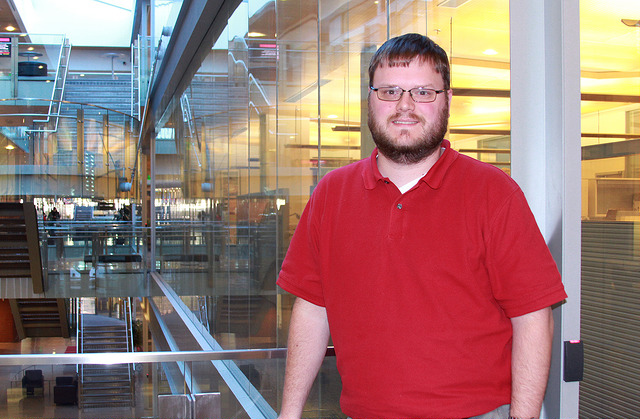Tiny, pond-dwelling organism reveals nearly bulletproof DNA

ASU Biodesign Institute geneticist Reed Cartwright and colleagues at the University of Houston and Indiana University have demonstrated that, when grown in the vegetative life cycle, Tetrahymena DNA is the most stable ever measured, nearly impervious to change.
Meet the tiny, hair-lined ciliate, Tetrahymena thermophila. This nondescript pond-loving, pear-shaped protist, only visible through the microscope, has long fascinated scientists — even fueling Nobel Prize discoveries — due to its highly unusual cellular biology and genetic structure.
Now, it turns out that Tetrahymena’s genome, its genetic blueprint, is even more fascinating than previously thought. ASU Biodesign Institute geneticist Reed Cartwright and colleagues at the University of Houston and Indiana University have demonstrated that, when grown in the vegetative life cycle, Tetrahymena DNA is the most stable ever measured, nearly impervious to change.
After growing 10 different isolated Tetrahymena lines for 1,000 generations in the lab, and sequencing the genomes at the start and the end of the experiment, they have measured the rate of change of its precious DNA blueprint across each generation. This measurement, called the mutation rate, was the lowest ever recorded for any organism.
“It is one-third lower than any prior mutation rate, and about 1,500 times lower than in humans,” said Cartwright, a professor in the School of Life Sciences and researcher at Biodesign’s Center for Personalized Diagnostics. “For every generation in humans, children inherit about 75 new mutations from their parents. This ciliate experiences 75 new mutations every 100,000 generations; it can go 1,000 generations without having a single mutation occur.”
The findings, published along with long-time collaborators Rebecca Zufall and Ricardo Azevedo from the University of Houston, were published recently in the journal Genome Biology and Evolution.
Cartwright has long been fascinated with studying mutations, the random changes in DNA that are the main drivers of evolution.
Every life form on the planet has the same genetic chemistry: using just four simple building blocks, known by the letters A, T, C and G, after their chemical names. The diversity of life is produced by varying the number and order of those letters.
Reed Cartwright measured the rate of change, called the mutation rate, which was the lowest ever recorded for any organism.
The great naturalist and science writer Lewis Thomas once marveled at this driving trial-and-error force of DNA: “The capacity to blunder slightly is the real marvel of DNA. Without this special attribute, we would still be anaerobic bacteria and there would be no music,” he wrote in the book “The Medusa and the Snail.”
But studying the DNA blundering of the Tetrahymena ciliate, might not seem like an obvious choice.
“I was working on finding mutations in various species and did a postdoc at the University of Houston, where I met Becky, who was doing the experimental side of the work with her former graduate student, Hongan Long,” Cartwright said. “They needed a computational biologist to help identify mutations, and that’s when I began to work on Tetrahymena.”
Co-author Michael Lynch and his lab at Indiana University had studied a similar ciliate, the Paramecium, that is the staple of science classrooms, and also found a low mutation rate. Since the most important biological processes are usually the most conserved throughout evolution, they wondered if the DNA of Tetrahymena also showed the same high-fidelity genome.
They undertook an experiment to evolve the ciliate entirely in a test tube, called experimental evolution. Here, they took individuals and divided them into 10 different lines, growing them each over a few months for more than 1,000 generations.
Fortunately, the average division time of Tetrahymena can be measured in hours, so by keeping the conditions just right, they could force the growth solely in the vegetative life cycle, where they divide by simple binary fission.
“As long as they are healthy and happy, they grow vegetatively. They don’t try to undergo meiosis or have sex,” Cartwright said. After 1,000 generations, Cartwright and colleagues used some tricks of Tetrahymena biology to isolate its DNA, and the next-generation DNA facility at the Biodesign Institute to sequence the DNA.
“Ciliates are just plain cool. ... This was just our first round of results, and we can’t wait to get to the next round."
– ASU Biodesign Institute geneticist Reed Cartwright
To their surprise, they only found a total of six mutations within the different Tetrahymena lines after more than 1,000 generations of growth and division. Cartwright, along with former Biodesign Institute scientist David Winter, had to specifically design a new software tool, called accMUlate, to find rare mutations in these types of experiments. The team spent a lot of effort looking for more mutations but did not find them, and is confident that Tetrahymena thermophila has the lowest mutation rate discovered so far.
The team has funding from the National Institutes of Health and is continuing to explore mutation processes in Tetrahymena. Importantly, the research team wants to investigate the big question of why Tetrahymena has such a low mutation rate. Cartwright has a few guesses, which they are very eager to explore.
“Ciliates are just plain cool,” Cartwright said. “It’s a cool, weird system. This was just our first round of results, and we can’t wait to get to the next round. We’ll have a lot of new data to improve our methods and understand more about ciliate genetics.”
Finding the answer could provide important clues to a new biological pathway that helps protect the fidelity of genomes, or identify molecules that are important for ensuring DNA copying is error-free, which could be adapted for biotechnology applications.
For amidst all of the “weird biology” of Tetrahymena, Cartwright doesn’t know where the next scientific answers will veer his research. But that is also part of the joy as he further explores mutations across the tree of life, that, over time, are the driving force of evolution.
More Science and technology

Cracking the code of online computer science clubs
Experts believe that involvement in college clubs and organizations increases student retention and helps learners build valuable…
Consortium for Science, Policy & Outcomes celebrates 25 years
For Arizona State University's Consortium for Science, Policy & Outcomes (CSPO), recognizing the past is just as important as…

Hacking satellites to fix our oceans and shoot for the stars
By Preesha KumarFrom memory foam mattresses to the camera and GPS navigation on our phones, technology that was developed for…
